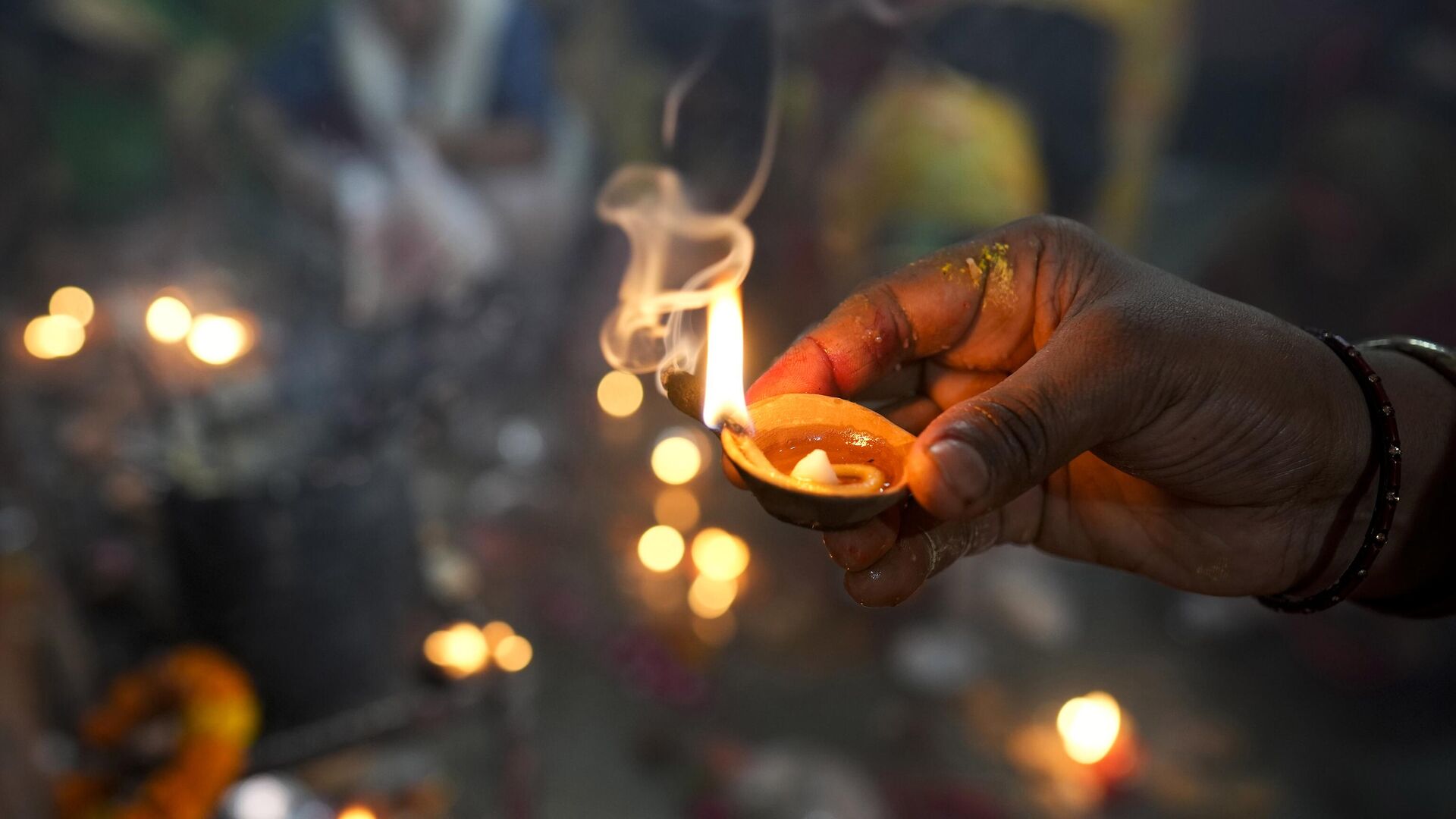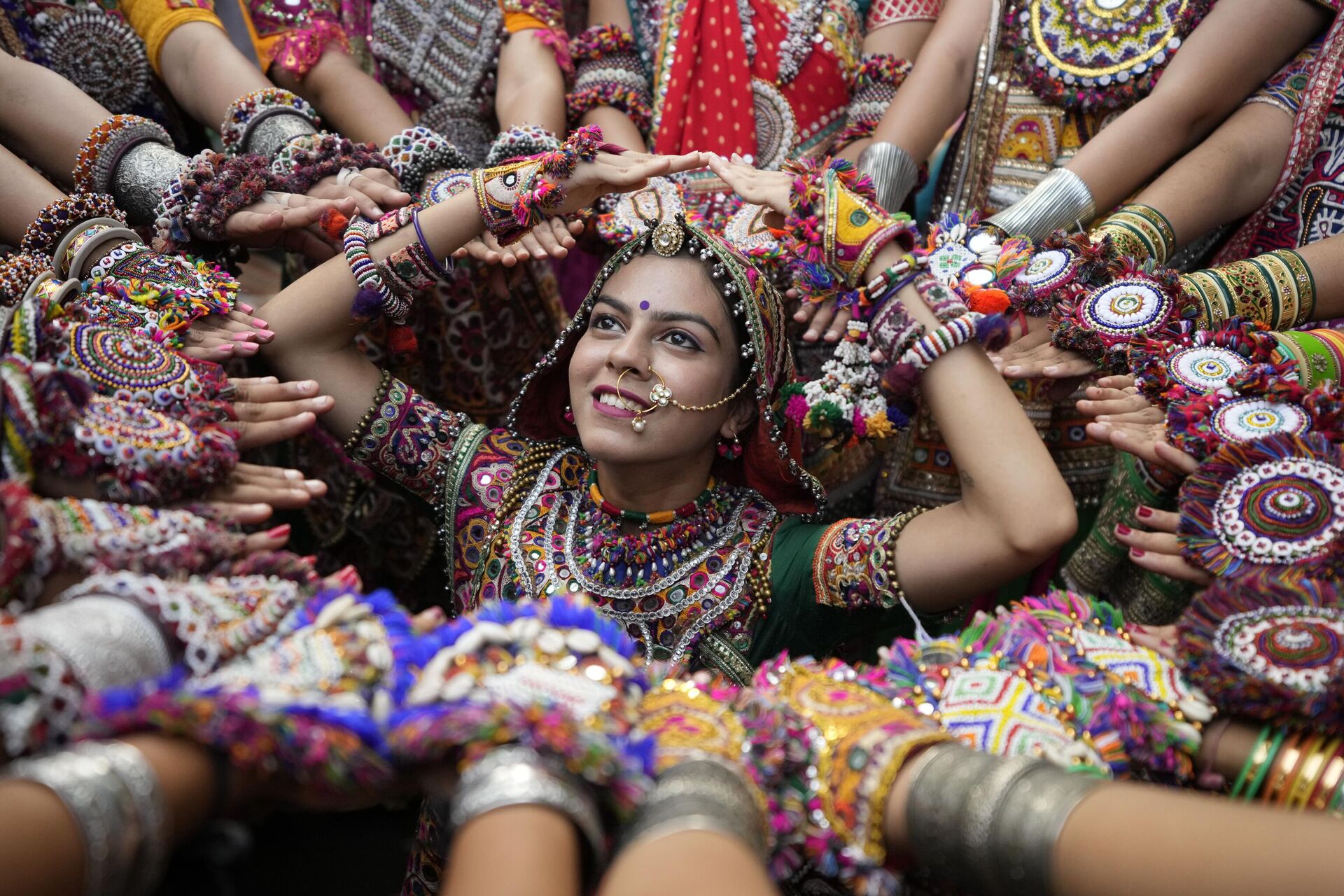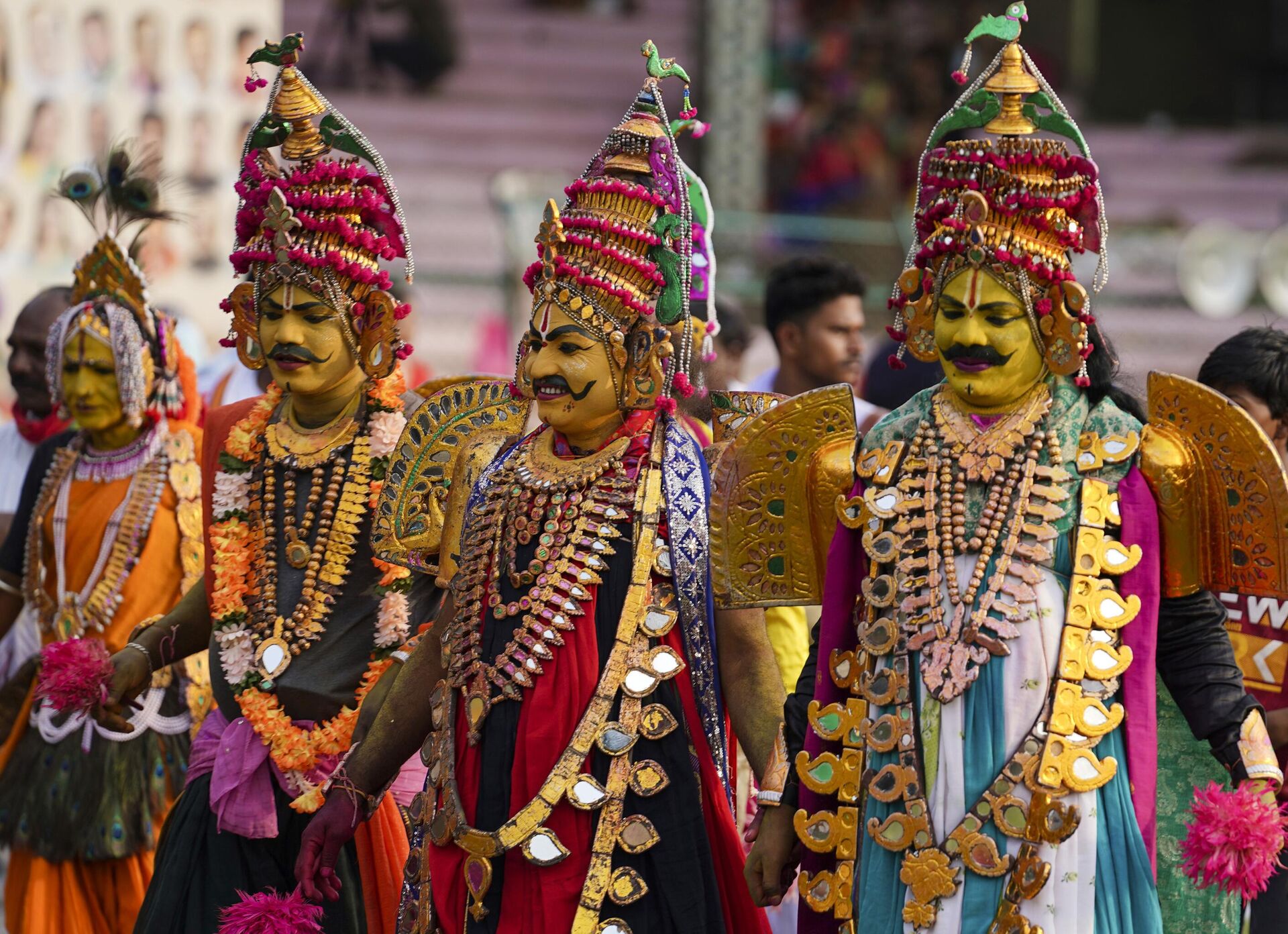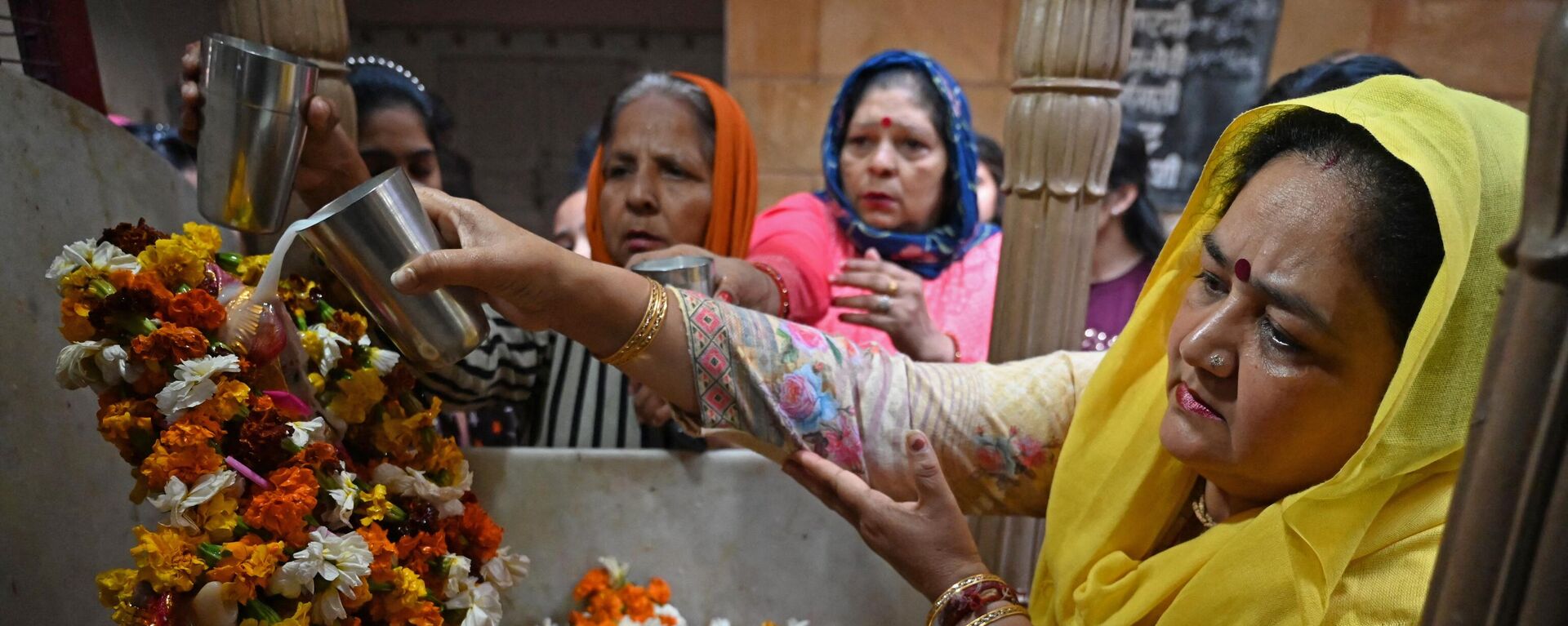https://sputniknews.in/20230927/navratri-nine-avatars-of-goddess-durga-worshipped-during-festival-4451765.html
Navratri: Nine Avatars of Goddess Durga Worshipped During Festival
Navratri: Nine Avatars of Goddess Durga Worshipped During Festival
Sputnik India
The Hindu festival of "Navratri", a Sanskrit word for "nine nights" is all set to begin from October 15.
2023-09-27T10:34+0530
2023-09-27T10:34+0530
2023-09-27T11:34+0530
india
hindu
hindu deities
hindu goddess kali
hindu devotees
hindu shrine
hindu festival
hindutva
hinduism
navratri
https://cdn1.img.sputniknews.in/img/07e7/09/1b/4464101_0:160:3072:1888_1920x0_80_0_0_4d78544f9b21e1112729b667fc8e0540.jpg
Hindu devotees in India and abroad are gearing up for the nine-day Navratri festival, which is celebrated with great pomp and enthusiasm.On each day of the festival, one out of nine divine incarnations of the goddess Durga is worshipped, signifying the power of womanhood, and is believed to protect people from negative forces.Sputnik India brings to you a complete list of the nine avatars of goddesses worshipped during Navratri.Day 1: Goddess ShailputriOn the first day of Navratri, the goddess Shailputri, also known as Parvati or Hemvati, is worshipped.According to legend, she is believed to be Lord Himalaya's daughter. She is often portrayed sitting on a bull, with a Trishul (a sharp divine weapon) held firmly in her right hand and a lotus flower in her left hand.Devotees worship her by chanting the mantra "Om Devi Shailaputryai Namah" 108 times and also sing Durga aarti and Shailputri aarti.Day 2: Goddess BrahmachariniOn the second day of Navratri, the goddess Brahmacharinim, the unmarried form of the goddess Parvati, is worshipped.As the legend goes, the goddess Brahmacharini performed hard austerity and severe penance (tapasya) for thousands of years to have Lord Shiva as her husband. Hence, she is called Brahmacharini.During her penance, it is said that she spent 1,000 years on a diet of flowers and fruits and another 100 years on a diet of leafy vegetables while sleeping on the floor.She is depicted as walking barefoot carrying Japa Mala (prayer beads) in her right hand and a Kamandal (oblong water pot) in the left.It is believed that Lord Mangal, the provider of all fortunes, is governed by the goddess Brahmacharini. She is believed to bestow her devotees with longevity.Day 3: Goddess ChandraghantaThe goddess Chandraghanta, the married avatar of the goddess Parvati, is worshipped on the third day of Navratri. After her marriage, the goddess Parvati adorned her forehead with a semi-circle or half-moon (Chandra), which looks like a bell (Ghanta). That's why she is known as the goddess Chandraghanta.The goddess with 10 hands portrayed sitting on a tigress is believed to be the destroyer of evil and establisher of peace in the land.With her left hand, the goddess Chandraghanta can be seen making a Varada Mudra pose and carrying a trishul, gada (mace weapon), sword, and kamandal (oblong water pot). While with her right hand, she can be seen carrying a lotus flower, an arrow, a dhanush (bow), and a Japa Mala, and making Abhaya Mudra pose. Devotees chant the mantra "Om Devi Chandraghantayai Namah" while worshipping the goddess Chandraghanta.Day 4: Goddess KushmandaThe goddess Kushmanda is worshipped on the fourth day of Navratra and is believed to have created the entire universe.The goddess is said to have the power and ability to live inside the Sun, providing direction and energy. Therefore, the sun god is governed by the goddess Kushmanda.The goddess rides on a lioness and is depicted with eight hands holding kamandal, dhanush, and lotus in her right hands, and a pot of nectar, jap mala, gada, and chakra in her left hands.Day 5: Goddess SkandmataAfter the goddess Parvati became the mother of Lord Skanda (also known as Lord Kartikeya or Lord Murugan), she was called the goddess Skandamata, who is worshipped on the fifth day of Navratri.The goddess with a white complexion is depicted sitting on a lion holding Lord Skanda in her lap, carrying lotus flowers in two hands, and making Abhaya Mudra in another hand.Day 6: Goddess KatyayaniThe goddess Katyayani, born at the home of the sage Katya, is worshipped on the sixth day of Navratri.She is said to be a warrior goddess and one of the fiercest forms of the goddess Durga, who killed the demon Mahishasura and brought peace to the world. The goddess Katyayani rides on a magnificent lion and is depicted with four hands carrying a lotus flower and sword in her left hands, and making Abhaya and Varada Mudras in another. Day 7: Goddess KalratriThe goddess Kalratri, also known as the goddess Shubankari, is worshipped on the seventh day of Navratri and bestows her devotees with calmness and courage.It is believed that the goddess' auspicious power (shubh) within her ferocious form makes her the destroyer of all demon entities, ghosts, evil spirits, and negative energies.The goddess Kalratri is known for killing the demon Raktabeej, who could multiply from every drop of his blood which fell on the ground. It is said that the goddess Kaalratri conquered him by licking up the blood before it could reach the ground.The goddess with a dark black color complexion rides on a donkey and has four hands. While she carries a sword and a deadly iron hook in her left hands, her right hands form an Abhaya and Varada Mudra pose. Day 8: Goddess MahagauriThe goddess Mahagauri, who is known to be an extremely fair avatar, is worshipped on the eighth day of the festival. According to legend, the goddess Parvati underwent severe penance to have Lord Shiva as her husband, due to which her complexion became dark and frail. Seeing her perseverance and pure devotion, Lord Shiva agreed to marry her and washed her with holy water from the Ganges. Upon this, her complexion became fair, golden, and radiant.The goddess Mahagauri's complexion was so fair that she was compared with a conch, the moon, and the jasmine flower. Donning white clothes, the goddess is depicted with four hands carrying a trishul and forming Abhaya Mudra with her right hands, and holding a Damaru and forming a Varada Mudra with her left hands.Day 9: Goddess SiddhidatriOn the last day of Navratri, the goddess Siddhidatri, the supreme goddess of power, is worshipped.It is believed that the goddess Siddhidatri got the name Adi-Parashakti after she emerged from the left side of Lord Shiva, and on this day, she accomplished the mighty feat of slaying the demon Mahishasura.She sits on a lotus, rides on a lion, and is depicted with four hands carrying a Gada (mace weapon), Chakra (discus weapon), lotus flower, and Shankh (conch).
https://sputniknews.in/20230819/when-is-navratri-in-2023-3682664.html
india
Sputnik India
feedback.hindi@sputniknews.com
+74956456601
MIA „Rossiya Segodnya“
2023
Sangeeta Yadav
https://cdn1.img.sputniknews.in/img/07e6/0c/0f/110602_0:0:641:640_100x100_80_0_0_c298016a79eb02ef8caa9d1f688c12a5.jpg
Sangeeta Yadav
https://cdn1.img.sputniknews.in/img/07e6/0c/0f/110602_0:0:641:640_100x100_80_0_0_c298016a79eb02ef8caa9d1f688c12a5.jpg
News
en_IN
Sputnik India
feedback.hindi@sputniknews.com
+74956456601
MIA „Rossiya Segodnya“
Sputnik India
feedback.hindi@sputniknews.com
+74956456601
MIA „Rossiya Segodnya“
Sangeeta Yadav
https://cdn1.img.sputniknews.in/img/07e6/0c/0f/110602_0:0:641:640_100x100_80_0_0_c298016a79eb02ef8caa9d1f688c12a5.jpg
navratri 2023, navratri, navratri 2023 march, navratri colours, happy navratri, chaitra navratri 2023, navratri 2023 date, navratri march 2023, navratri kab hai, navratri image, navratri colour, navratri wishes, navratri 2023 march date, navratri kab se hai, happy navratri wishes, navratri wishes in hindi, goddess durga, incarnations, vijaydashmi, dussehra festival, lord rama, ravana, why is 'navratri' celebrated?power of womanhood, chaitra navratri, sharada navratre, devotees worship, goddess shailaputri, goddess brahmacharini, goddess chandraghanta, goddess kushmanda, goddess skandamata, goddess katyayani, goddess kaalaratri, goddess mahagauri, goddess siddhidatri, shubh mahurat, how is navratri celebrated?temples, durga puja pandals, worshipping idols of goddess durga, navratri colors, dhunuchi dance, folk dance garba, dandiya, fast during navratri, fasting during navratri, navratra special vegetarian, navratri recipes,
navratri 2023, navratri, navratri 2023 march, navratri colours, happy navratri, chaitra navratri 2023, navratri 2023 date, navratri march 2023, navratri kab hai, navratri image, navratri colour, navratri wishes, navratri 2023 march date, navratri kab se hai, happy navratri wishes, navratri wishes in hindi, goddess durga, incarnations, vijaydashmi, dussehra festival, lord rama, ravana, why is 'navratri' celebrated?power of womanhood, chaitra navratri, sharada navratre, devotees worship, goddess shailaputri, goddess brahmacharini, goddess chandraghanta, goddess kushmanda, goddess skandamata, goddess katyayani, goddess kaalaratri, goddess mahagauri, goddess siddhidatri, shubh mahurat, how is navratri celebrated?temples, durga puja pandals, worshipping idols of goddess durga, navratri colors, dhunuchi dance, folk dance garba, dandiya, fast during navratri, fasting during navratri, navratra special vegetarian, navratri recipes,
Hindu devotees in India and abroad are gearing up for the nine-day Navratri festival, which is celebrated with great pomp and enthusiasm.
On each day of the festival, one out of nine divine incarnations of the goddess Durga is worshipped, signifying the power of womanhood, and is believed to protect people from negative forces.
Sputnik India brings to you a complete list of the
nine avatars of goddesses worshipped during
Navratri.
Day 1: Goddess Shailputri
On the first day of Navratri, the goddess Shailputri, also known as Parvati or Hemvati, is worshipped.
According to legend, she is believed to be Lord Himalaya's daughter. She is often portrayed sitting on a bull, with a Trishul (a sharp divine weapon) held firmly in her right hand and a
lotus flower in her left hand.
Devotees worship her by chanting the mantra "Om Devi Shailaputryai Namah" 108 times and also sing Durga aarti and Shailputri aarti.
Day 2: Goddess Brahmacharini
On the second day of Navratri, the goddess Brahmacharinim, the unmarried form of the goddess Parvati, is worshipped.
As the legend goes, the goddess Brahmacharini performed hard austerity and severe penance (tapasya) for thousands of years to have Lord Shiva as her husband. Hence, she is called Brahmacharini.
During her penance, it is said that she spent 1,000 years on a diet of flowers and fruits and another 100 years on a diet of leafy
vegetables while sleeping on the floor.
She is depicted as walking barefoot carrying Japa Mala (prayer beads) in her right hand and a Kamandal (oblong water pot) in the left.
It is believed that Lord Mangal, the provider of all fortunes, is governed by the goddess Brahmacharini. She is believed to bestow her devotees with longevity.
Day 3: Goddess Chandraghanta
The goddess Chandraghanta, the married avatar of the goddess Parvati, is worshipped on the third day of Navratri.
After her marriage, the goddess Parvati adorned her forehead with a semi-circle or half-moon (Chandra), which looks like a bell (Ghanta). That's why she is known as the goddess Chandraghanta.
The goddess with 10 hands portrayed sitting on a tigress is believed to be the destroyer of evil and
establisher of peace in the land.
With her left hand, the goddess Chandraghanta can be seen making a Varada Mudra pose and carrying a trishul, gada (mace weapon), sword, and kamandal (oblong water pot). While with her right hand, she can be seen carrying a lotus flower, an arrow, a dhanush (bow), and a Japa Mala, and making Abhaya Mudra pose.
Devotees chant the mantra "Om Devi Chandraghantayai Namah" while worshipping the goddess Chandraghanta.
The goddess Kushmanda is worshipped on the fourth day of Navratra and is believed to have created the entire universe.
The goddess is said to have the power and ability to live inside the Sun, providing direction and energy. Therefore, the sun god is governed by the goddess Kushmanda.
The goddess rides on a lioness and is depicted with eight hands holding kamandal, dhanush, and lotus in her right hands, and a pot of nectar, jap mala, gada, and chakra in her left hands.
After the goddess Parvati became the mother of Lord Skanda (also known as Lord Kartikeya or Lord Murugan), she was called the goddess Skandamata, who is worshipped on the fifth day of Navratri.
The
goddess with a white complexion is depicted sitting on a lion holding Lord Skanda in her lap, carrying lotus flowers in two hands, and making Abhaya Mudra in another hand.
The goddess Katyayani, born at the home of the sage Katya, is worshipped on the sixth day of Navratri.
She is said to be a warrior goddess and one of the fiercest forms of the goddess Durga, who killed the demon Mahishasura and brought
peace to the world.
The goddess Katyayani rides on a magnificent lion and is depicted with four hands carrying a lotus flower and sword in her left hands, and making Abhaya and Varada Mudras in another.
The goddess Kalratri, also known as the goddess Shubankari, is worshipped on the seventh day of Navratri and bestows her devotees with calmness and courage.
It is believed that the goddess' auspicious power (shubh) within her ferocious form makes her the destroyer of all demon entities, ghosts, evil spirits, and negative energies.
The goddess Kalratri is known for killing the demon Raktabeej, who could multiply from every drop of his blood which fell on the ground. It is said that the goddess Kaalratri conquered him by licking up the blood before it could reach the ground.
The goddess with a dark black color complexion rides on a donkey and has four hands. While she carries a sword and a deadly iron hook in her left hands, her right hands form an Abhaya and Varada Mudra pose.
The goddess Mahagauri, who is known to be an extremely fair avatar, is worshipped on the eighth day of the festival.
According to legend, the goddess Parvati underwent severe penance to have Lord Shiva as her husband, due to which her complexion became dark and frail.
Seeing her perseverance and pure devotion, Lord Shiva agreed to marry her and washed her with
holy water from the Ganges. Upon this, her complexion became fair, golden, and radiant.
The goddess Mahagauri's complexion was so fair that she was compared with a conch, the moon, and the jasmine flower.
Donning white clothes, the goddess is depicted with four hands carrying a trishul and forming Abhaya Mudra with her right hands, and holding a Damaru and forming a Varada Mudra with her left hands.
Day 9: Goddess Siddhidatri
On the last day of Navratri, the goddess Siddhidatri, the supreme goddess of power, is worshipped.
It is believed that the goddess Siddhidatri got the name Adi-Parashakti after she emerged from the left side of Lord Shiva, and on this day, she accomplished the mighty feat of slaying the demon Mahishasura.
She sits on a lotus, rides on a lion, and is depicted with four hands carrying a Gada (mace weapon), Chakra (discus weapon), lotus flower, and Shankh (conch).






